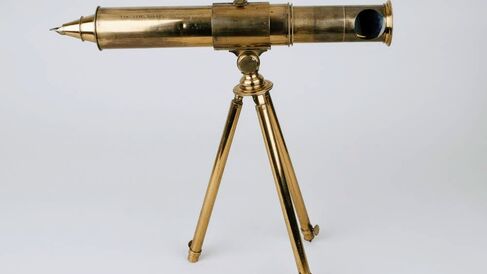Art and Astronomy: Cornelius Varley

An instrument maker and artist, Cornelius Varley came from a talented family. In the early 19th century he invented an instrument called the graphic telescope (Image 1), which allowed accurate drawings of any subject. The graphic telescope was used by Varley himself to record astronomical events, and sketch portraits and landscapes.
Many early-modern astronomical instruments - including sundials, quadrants, and astrolabes - carry maps of the heavens. An important method for drawing such star maps is called stereographic projection, the plotting of 3 dimensions onto 2 dimensions. Such projections allow complex astronomical calculations to be made without the use of a cumbersome celestial globe or advanced knowledge of mathematics.
On this page, readers can download a copy of Anita McConnell's research monograph, A Survey of the Networks Bringing a Knowledge of Optical Glass-Working to the London Trade, 1500-1800. The Whipple Museum is delighted to be able to make this important work widely available for the first time, as a free pdf download.
Observation and artistic skills
Cornelius Varley (1791-1873) was the second eldest of five talented siblings. The best known of these, his brother John, was a renowned artist who worked with both William Blake and John Constable. Cornelius was also a gifted artist, but spent much of his life working as a maker of scientific instruments. During his lifetime these two areas of craftsmanship were not far removed from one another: many artists considered themselves to be examining nature using observational techniques that were just as valid as the techniques of contemporary naturalists. Furthermore, artistic skills have often been necessary in science, for example, when recording what is seen through a microscope or telescope.
Varley himself linked the two disciplines by inventing an optical aid for artists called the graphic telescope. His drawings and paintings are now in the collections of, among others, Tate Britain, the Fine Arts Museum of San Francisco, the National Portrait Gallery, and the Fitzwilliam Museum in Cambridge.
Varley's other projects
Varley's artworks contain some distinctive and interesting techniques. He used his invention to sketch landscapes accurately, and in a less stylised manner than some of his contemporaries. He ignored the standard conventions of landscape composition, which were more concerned with 'improving' nature than recording it. Another example of the naturalistic movement in art, which can be seen in Varley's drawings and watercolours, is a more precise representation of trees based on an understanding of their biological makeup.
Varley was an active member of the scientific community: the Whipple Museum owns a set of live cages that were Varley's own equipment; he made sundials (Image 1), microscopes, and other instruments; he invented a type of microscope stage which allowed smooth sideways movement (Image 2). Between 1845 and 1858 he made at least 20 astronomical pictures of comets, planets, and stars with his graphic telescope. This is his best known invention, and it was patented in 1811 as a device which enabled artists to project magnified images on to paper. The Whipple Museum owns a graphic telescope made by Varley around 1840, which is signed: "CORNELIUS VARLEY. Patent Graphic Telescope".
Read more: the graphic telescope and Varley's artwork
Boris Jardine
Boris Jardine, 'Cornelius Varley: artist, astronomer, and instrument maker', Explore Whipple Collections, Whipple Museum of the History of Science, University of Cambridge, 2008
